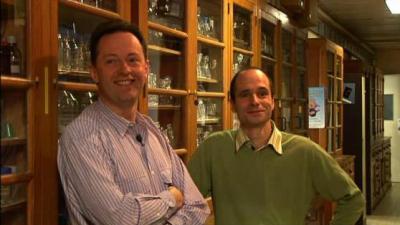Douglas Anderson, Robert Henderson, Roger Lucas
Scanning laser ophthalmoscope
European Inventor of the Year 2008 in the category "SMEs/research"
In the early 1990s, the young son of Douglas Anderson was undergoing regular eye exams. They were uncomfortable, especially for such a young child, and yielded at best incomplete results.
In 1992 Douglas' son, then 5 years old, went blind in one eye when a retinal detachment was detected too late. Anderson devoted himself to finding a child-friendly method of conducting an examination of the retina that would yield complete and thorough images without the need for dilation.
After some years of testing within Crombie Anderson, a British product design consultancy, Anderson, together with Robert Henderson, an optical engineer who then worked as an external consultant, and Roger Lucas, patented the first scanning laser ophthalmoscope able to scan a very wide field of the retina. That same year Douglas founded Optos, a spin-off of Crombie Anderson, a company headquartered in Dunfermline, Scotland, that by the time of its initial public offering on the London Stock Exchange in February 2006 had revolutionised the way eye exams are conducted. It raised some $54 million in equity the day it went public.
While Optos began operations in the United Kingdom and the United States, it has since expanded distribution to Canada and continental Europe, operating now in France, Germany, Norway, Spain and Switzerland.
Optos generated $86.8 million in revenue for the year ended 30 September 2007, representing growth of 28 percent over the previous year.
How it works
The Optos scanning laser ophthalmoscope is a proprietary medical device that generates a complete retinal exam. Unlike conventional ways of looking at the retina, the device uses a very low-level laser beam to provide a high-resolution ultra-wide-field digital image that captures approximately 82 percent of the retina in a single scan.
The scanning laser system combines two low-powered lasers into a single beam that is then projected onto the patient's retina and manipulated through a 200-degree scan angle. Light reflected from the retina is then returned through the scanning system and converted into electrical impulses by highly sensitive photo diodes. These impulses are in turn digitised and formatted to create a digital image that can be stored and later compared to other images. The retinal exam can be completed in a quarter of a second and does not require pupil dilation, whereas conventional retinal imaging methods take longer and are more invasive and less patient-friendly.
Contact
European Inventor Award and Young Inventors Prize queries:
european-inventor@epo.org Subscribe to the European Inventor Award newsletterMedia-related queries:
Contact our Press team#InventorAward #YoungInventors




